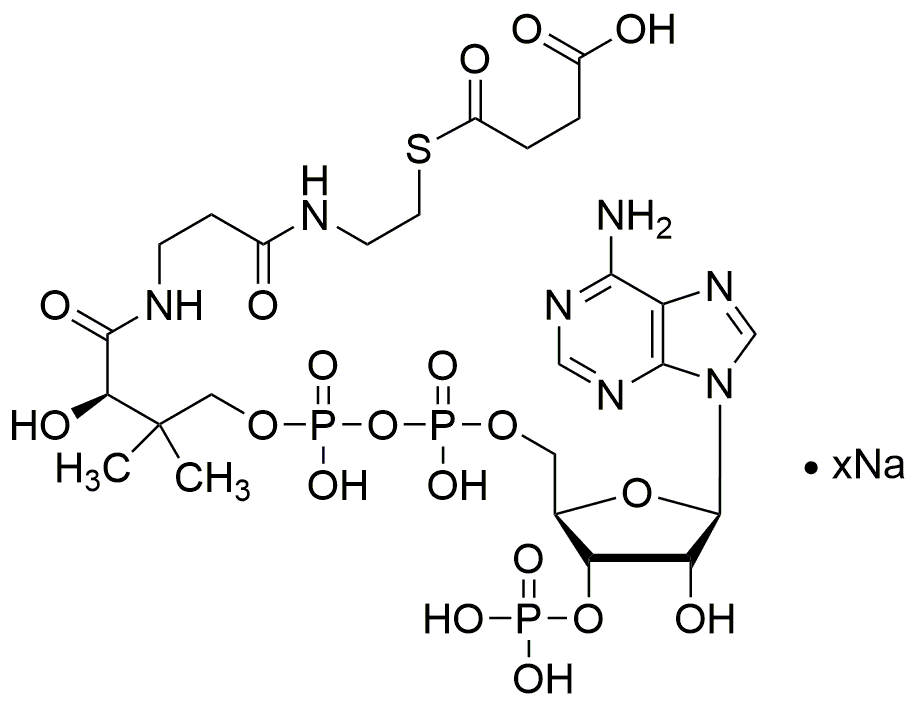Succinyl coenzyme A sodium salt is widely utilized in research focused on:
- Metabolic Studies: This compound plays a crucial role in the citric acid cycle, making it essential for researchers studying cellular respiration and energy production in various organisms.
- Biochemical Assays: It is commonly used in enzyme assays to evaluate the activity of enzymes involved in metabolic pathways, providing insights into enzyme kinetics and regulation.
- Pharmaceutical Development: The compound is explored in drug formulation, particularly in the development of therapies targeting metabolic disorders, enhancing drug efficacy and bioavailability.
- Food Industry Applications: Its role as a food additive helps in flavor enhancement and preservation, making it valuable for food scientists working on product development and safety.
- Biotechnology: Used in the production of biofuels and bioproducts, it supports researchers in optimizing fermentation processes and improving yield in microbial cultures.
General Information
Properties
Safety and Regulations
Applications
Succinyl coenzyme A sodium salt is widely utilized in research focused on:
- Metabolic Studies: This compound plays a crucial role in the citric acid cycle, making it essential for researchers studying cellular respiration and energy production in various organisms.
- Biochemical Assays: It is commonly used in enzyme assays to evaluate the activity of enzymes involved in metabolic pathways, providing insights into enzyme kinetics and regulation.
- Pharmaceutical Development: The compound is explored in drug formulation, particularly in the development of therapies targeting metabolic disorders, enhancing drug efficacy and bioavailability.
- Food Industry Applications: Its role as a food additive helps in flavor enhancement and preservation, making it valuable for food scientists working on product development and safety.
- Biotechnology: Used in the production of biofuels and bioproducts, it supports researchers in optimizing fermentation processes and improving yield in microbial cultures.
Documents
Safety Data Sheets (SDS)
The SDS provides comprehensive safety information on handling, storage, and disposal of the product.
Product Specification (PS)
The PS provides a comprehensive breakdown of the product’s properties, including chemical composition, physical state, purity, and storage requirements. It also details acceptable quality ranges and the product's intended applications.
Certificates of Analysis (COA)
Search for Certificates of Analysis (COA) by entering the products Lot Number. Lot and Batch Numbers can be found on a product’s label following the words ‘Lot’ or ‘Batch’.
*Catalog Number
*Lot Number
Certificates Of Origin (COO)
This COO confirms the country where the product was manufactured, and also details the materials and components used in it and whether it is derived from natural, synthetic, or other specific sources. This certificate may be required for customs, trade, and regulatory compliance.
*Catalog Number
*Lot Number
Safety Data Sheets (SDS)
The SDS provides comprehensive safety information on handling, storage, and disposal of the product.
DownloadProduct Specification (PS)
The PS provides a comprehensive breakdown of the product’s properties, including chemical composition, physical state, purity, and storage requirements. It also details acceptable quality ranges and the product's intended applications.
DownloadCertificates of Analysis (COA)
Search for Certificates of Analysis (COA) by entering the products Lot Number. Lot and Batch Numbers can be found on a product’s label following the words ‘Lot’ or ‘Batch’.
*Catalog Number
*Lot Number
Certificates Of Origin (COO)
This COO confirms the country where the product was manufactured, and also details the materials and components used in it and whether it is derived from natural, synthetic, or other specific sources. This certificate may be required for customs, trade, and regulatory compliance.


